#Edit Rudolph Valentino!!!
Explore tagged Tumblr posts
Text
I regret never tagging things properly because I definitely have several old posts mocking how every single micro-generation act like they invented bishounen, and every single micro-gen+five years acts like the historically unforeseen event of people wanting to fuck beautiful young men will be what destroys us
#BTS One Direction Justin Beiber Hanson Leonardo Dicaprio Johnny Depp Prince Shaun Cassidy#there was a beautiful actor from the 1910s-30s whose name I'm blanking on but he died an extremely early death#you better believe your great great great grandma was weeping over her jungkook#Edit Rudolph Valentino!!!
20 notes
·
View notes
Text

Rudolph Valentino and Gloria Swanson photographed by Donald Biddle Keyes from Motion Picture Magazine, May 1922
original caption:
As In Days Beyond Recall An Attractive Study of Gloria Swanson and Rudolph Valentino in "Beyond the Rocks"
#1920s#1922#silent era#rudolph valentino#gloria swanson#donald biddle keyes#photography#film costume#silent cinema#silent film#classic hollywood#classic film stars#classic cinema#vintage magazine#my edit#fan magazine#film magazine
52 notes
·
View notes
Text
AHS Hotel (2015)
Finn Wittrock as Tristan Duffy and Rudolph Valentino
#finn wittrock#finn wittrock edit#tristan duffy#rudolph valentino#american horror story#ahs#ahs edit#ahs hotel#anabluetz
34 notes
·
View notes
Text
Stage star Carter DeHaven seemingly transforms himself into a series of silent-era screen stars including Buster Keaton, Harold Lloyd, Roscoe Arbuckle, Rudolph Valentino, Douglas Fairbanks, and Jackie Coogan.
#buster keaton#1930s#1910s#1920s#1920s hollywood#silenst film#silent comedy#silent cinema#silent era#silent movies#pre code#pre code hollywood#pre code film#pre code era#pre code movies#damfino#damfinos#vintage hollywood#black and white#buster edit#old hollywood#slapstick#carter dehaven#harold lloyd#roscoe arbuckle#rudolph valentino#douglas fairbanks#jackie coogan
21 notes
·
View notes
Note
Not sure if you are on twitter too so I am not sure if you heard, but the Uglies movie will come to Netflix this year 13th September. God, I hope so much it is just as good as the books...
Interesting! I wonder how they're going to do some parts of it, like the fact that the characters all have to be within a specific, very narrow range of skin tones- at least, the Pretty ones who aren't allowed to be very light- or dark-skinned, but I'm willing to bet the Ugly characters shouldn't look totally one race or another either after so many years of genetic intermingling.
There's also going to be a lot of CGI involved in the Pretties, if they do it right. We're not just talking supermodel- one whole point is that it's a very specific template of beauty. I guess a few Natural Pretties who lived after photography but during the before-times are mentioned, so those could give us an idea, including Lillian Russell:
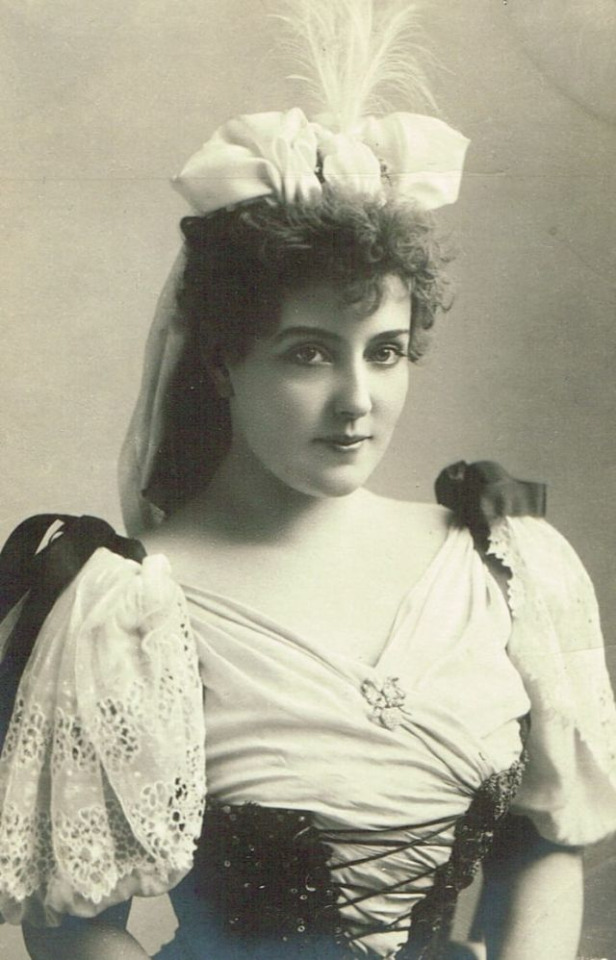
and Rudolph Valentino:
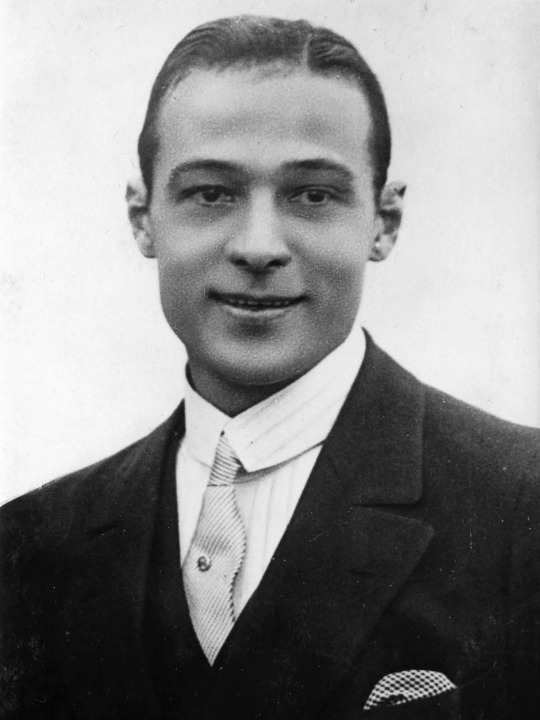
there's also a "Denzel" mentioned, but I have no idea who that's about. Denzel Washington hardly looks the part, IMO. maybe when he was younger, I guess?
(others, like Cleopatra and Nefertiti, seem to just be people who were famous for their beauty since nobody can really conclusively say what they looked like. it's also kind of ironic- nobody alive at that point saw Russell or Valentino in person, and they maybe don't realize- or care -that photo editing existed back then. so it's possible they weren't as Pretty as everyone thinks, IRL)
And to have the appropriate contrast after the operation, they're going to have to make the actors look very different. So I'm curious to see how that will go down.
I guess we'll see! Gods, it's so weird to be getting an adaptation of that after all this time- I remember first reading those books when I was like 11. Specials hadn't even come out yet.
#ask#anon#uglies#scott westerfeld#Laverne Cox is in it which checks out#they won't have to CGI her much; I feel like she already looks fairly Pretty#her role is TBA so I'm wondering if she's playing Dr. Cable or something#I guess she could be...oh David's mother. I forget her name. but I feel like she doesn't look average enough for that#although I guess they could make the point that after living in that world even a real-world gorgeous person looks 'ugly' to Tally
90 notes
·
View notes
Text
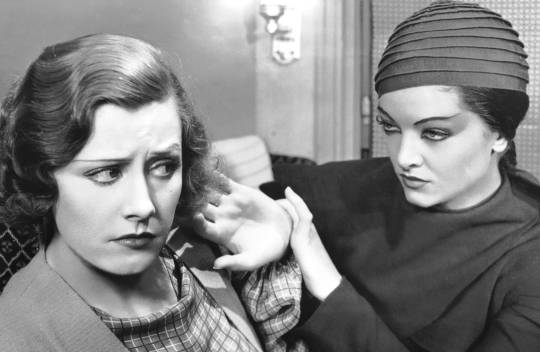
Irene Dunne and Myrna Loy in Thirteen Women (George Archainbaud, 1932)
Cast: Irene Dunne, Myrna Loy, Ricardo Cortez, Jill Esmond, Mary Duncan, Kay Johnson, Florence Eldridge, C. Henry Gordon, Peg Entwistle, Harriet Hagman, Edward Pawley, Blanche Friderici, Wally Albright. Screenplay: Bartlett Cormack, Samuel Ornitz, based on a novel by Tiffany Thayer. Cinematography: Leo Tover. Art direction: Carroll Clark. Film editing: Charles L. Kimball. Music: Max Steiner.
Myrna Loy was born Myrna Williams in Helena, Montana, but you wouldn't know it from the way Hollywood often cast her at the start of her career in the '20s and '30s. Her role in Thirteen Women is probably the purest example of her work as the stereotypical sinister Eurasian. She plays Ursula Georgi, whom the cop played by Ricardo Cortez scorns as "Half-breed type. Half Hindu, half Javanese, I don't know." (Actually, Cortez himself knew something about crossing ethnic lines: He was born Jacob Krantz in New York, but Hollywood changed his name to capitalize on the vogue for Latin lovers like Rudolph Valentino and Ramon Novarro, and later claimed first that he was French and later that he was born in Vienna.) Ursula seeks revenge on the women who belonged to a sorority at a girls' college and blackballed her when she sought admission. She seeks out a phony seer known as Swami Yogadachi (C. Henry Gordon), whose horoscope readings the girls sought out, and hypnotizes him into sending them poison-pen readings that predict dire events. Two of the girls, the sisters June (Mary Duncan) and May Raskob (Harriet Hagman), have become trapeze artists, and June is so unnerved by the fake reading that she lets May fall to her death during a stunt and goes mad as a consequence. As others fall prey to Ursula's schemes, some of the survivors gather at the home of Laura Stanhope (Irene Dunne), who thinks that their hysteria over the deaths is absurd. Laura is the single mother of a son, Bobby (Wally Albright), who is one of those cloyingly cute movie children -- he calls her "Mumsy." But even Laura's calm vanishes when Ursula makes Bobby her next target. In addition to being stupidly racist, the movie is sheer hokum, a cockamamie blend of revenge thriller and police procedural, and it was not much of a success at the box office, even after RKO cut 14 minutes from it after test screenings -- one of the reasons why we learn the fates of only 10 of the 13 women. One of the performances cut to only four minutes was that of Peg Entwistle, who played Hazel, the one who kills her husband and goes to prison. Entwistle was reportedly so despondent about her movie career that she climbed to the top of one of the letters on the Hollywood sign (reports vary on whether it was the H or the D) and jumped to her death. As for Loy, this was her last outing as a Eurasian vamp: The Thin Man (W.S. Van Dyke, 1934) changed her screen image to that of the witty and soignée wife, most often of William Powell.
26 notes
·
View notes
Text

(click to view original page)
A review of Alla Nazimova’s 1922 film Salomé, from the August 1922 edition of Photoplay. Full text follows — note that “Mrs. Valentino” refers to Natacha Rambova, then married to Rudolph Valentino:
Salome — Alla Nazimova Production
Oscar Wilde’s "Salome" is a thing of acute aesthetic appeal — a hot house orchid of decadent passion. Alla Nazimova and Mrs. Valentino, who designed the sets and costumes after Aubrey Beardsley, have kept in a good measure to the original, although Herod and his queen, we fear, savor a bit of Sennett rather than of old Judea as Oscar painted it with his lavish adjectives. The action of the film adaptation has all the speed of a "slow motion" reel. That is, all but the Dance of the Seven Veils.
We are not sure whether we like Madame Nazimova's idea of Salome as a petulant little princess with a Freudian complex and a headdress of glass bubbles. We rather believe such a Salome would not have stirred men so in those good old pagan days. You have our warning: this is bizarre stuff.
2 notes
·
View notes
Text
My Rudolph Valentino Christmas edits ❤️🎄🌹


1 note
·
View note
Video
Vilma Banky by Truus, Bob & Jan too! Via Flickr: French postcard ny Editions Cinémagazine, no. 428. Photo: Vilma Banky in The Winning of Barbara Worth (Henry King, 1926), also with Ronald Colman and a young Gary Cooper, who debuted in this film. Hungarian-born silent film star Vilma Bánky (1898-1991) filmed in Budapest, France, Austria, and Germany, before Sam Goldwyn took her to Hollywood. There she starred opposite great silent stars like Rudolph Valentino and Ronald Colman. She became Goldwyn's biggest money maker till sound finished her career. For more postcards, a bio and clips check out our blog European Film Star Postcards or follow us at Tumblr.
0 notes
Text
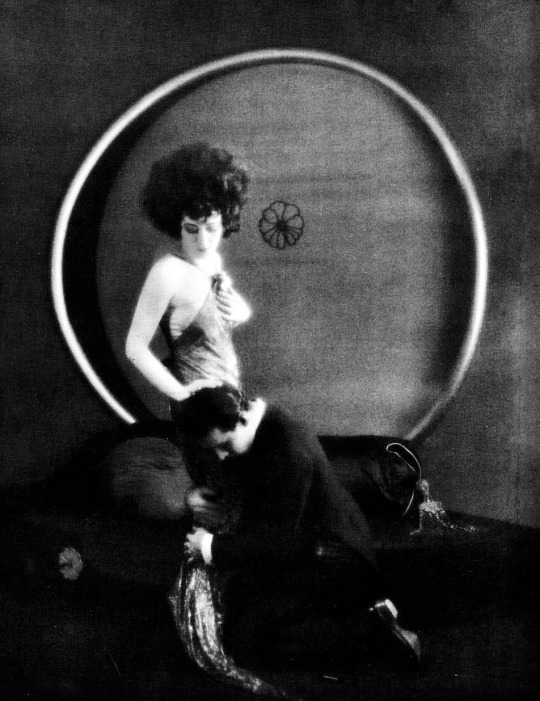
Alla Nazimova and Rudolph Valentino in “Camille”, 1921
#alla nazimova#rudolph valentino#camille#1920s#1921#silent films#silent movies#userelizaormandy#our edits
284 notes
·
View notes
Text
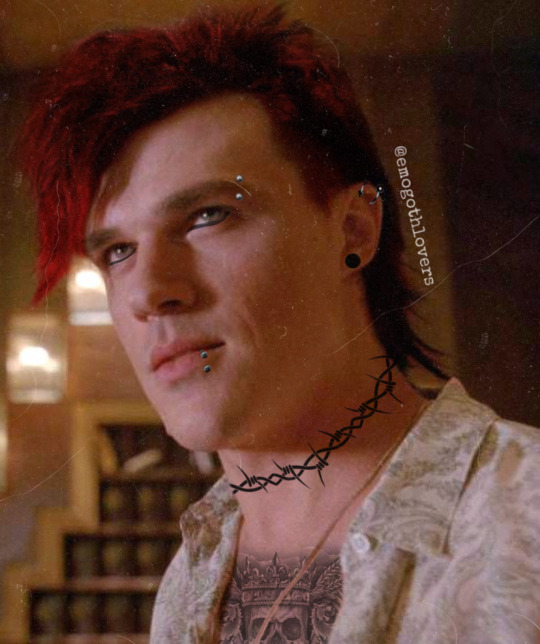
☠️Tristan Duffy☠️
#tristan duffy#finn wittrock#american horror story#american horror story hotel#ahs#american horror story freak show#american horror story 1984#american horror story roanoke#american horror story double feature#american horror story red tide#dandy mott#rudolph valentino#jether polk#bobby richter#harry gardner#punk edit#photoshop
9 notes
·
View notes
Text

from Motion Picture Magazine, September 1923
Portrait of Rudolph Valentino and Natacha Rambova by Hal Phyfe
#1920s#1923#rudolph valentino#natacha rambova#hal phyfe#my edit#film magazine#fan magazine#classic hollywood#classic movies#vintage style#old hollywood#classic cinema#silent cinema#silent era#silent film#silent movies#illustration#portraits#hollywood glamour#old hollywod glamour
128 notes
·
View notes
Text
AHS Hotel (2015)
Finn Wittrock as Rudolph Valentino
#finn wittrock#finn wittrock edit#ahs#american horror story#ahs edit#ahs hotel#rudolph valentino#anabluetz
21 notes
·
View notes
Text

Vilma Banky and Rudolph Valentino in The Eagle (Clarence Brown, 1925)
Cast: Rudolph Valentino, Vilma Banky, Louise Dresser, Albert Conti, James A. Marcus, George Nichols, Carrie Clark Ward. Screenplay: Hanns Kräly, based on a novel by Alexander Pushkin; titles: George Marion Jr. Cinematography: George Barnes. Production design: William Cameron Menzies. Film editing: Hal C. Kern.
It's easy to overlook the absurdities of the story of The Eagle because the filmmakers embrace them, and everyone seems to be having so much fun. Rudolph Valentino is Vladimir Dubrovsky, a dashing (what else?) lieutenant in the Russian Imperial Guard, who catches the eye of Catherine the Great (Louise Dresser) when he rescues a pretty young woman (Vilma Banky) and her aunt (Carrie Clark Ward) from a carriage pulled by a runaway horse. Catherine wants him for herself, of course, but Vladimir is shocked by her advances and flees. Meanwhile, he learns that his father has been victimized by a wicked aristocrat, Kyrilla Troekouroff(James A. Marcus), who has confiscated his lands. When his father dies, Vladimir vows vengeance against Kyrilla, and assumes the identity of the Black Eagle, a Zorro-like figure who wears a mask and rights the wrongs of Kyrilla against the peasantry. (In fact, the Black Eagle wasn't in the Pushkin story on which the movie is based; he was inspired by the success of the 1920 Douglas Fairbanks swashbuckler The Mark of Zorro directed by Fred Niblo.) And wouldn't you know it, Kyrilla's daughter, Mascha, turns out to be the pretty young woman he rescued in the runaway carriage. Disguising himself as a French teacher, he works his way into Kyrilla's household and woos Mascha. Meanwhile, the empress has put a price on Vladimir's head for desertion, so when he manages to win Masca and defeat her father, he still faces a firing squad. This is probably Valentino's most light-hearted performance, and he gets fine support from Banky and especially Dresser as the randy czarina.
9 notes
·
View notes
Photo

Rita Hayworth displays The Rudolph Valentino Prize statuette she was awarded for her role in “Career Excellence” along with Glenn Ford, 1978
102 notes
·
View notes
Text
Miss and Edge's fandom list
Below is lists for Miss and Edge of series/chracters you can request fics, or headcanons for.
Miss
The Witcher (2019-2022-): Unfortunately I only know the show as of right now, hopeful to read or play a game in the near future. Character X Reader/OC or Character/Reader(oc)/Character. Fluff/Angst/Smut/Headcanons
Geralt of Rivia
Yennefer
Dandelion
Stranger Things (2016-2022-): Will only write the following character for smut, all of these can be Character(s) X Reader/OC or the Ship. All other characters for other formats. Fluff/Angst/Smut/Headcanons.
Steve Harrington
Billy Hargrove
Eddie Munson
Robin Buckley
Steddie, Steddie X Reader
Harringrove, Harringrove X Reader
Mungrove, Mungrove X Reader
Ronance
Arcane (2021-): Character X Reader/OC, will consider certain ships. Fluff/Angst/Smut/Headcanons.
Vi
Jinx
Caitlyn Kiramman
Viktor
Silco
Vander
A Court of Thorns and Roses+ : Character X Reader/OC, I will take considerations for other characters but it might be biased. Fluff/Angst/Smut/Headcanons.
Cassian
Nesta
Lucien
Feyre X Rhysand X Reader
Azriel X Rhysand’s Sister
Game of Thrones: Character X Reader/OC only, will not contribute to cannon incest. Fluff/Angst/Smut/Headcanons.
Daenerys Targaryen
Jon Snow
Robb Stark
Daario Naharis
Yara Greyjoy
Jaime Lannister
Rhaenyra Targaryen
Daemon Targaryen
Aemond Targaryen
BBC Merlin (2008): Character X Reader/OC. Fluff/Angst/Smut/Headcanons.
Merlin
Arthur Pendragon
Gawain
Morgause
Guinevere
Morgana
X-men: Character X Reader/ OC. Fluff/Angst/Smut/Headcanons
First Class/Days of Future Past/Apocalypse:
Erik Lensherr/ Magneto
Raven/ Mystic
Charles Xavier/ Professor X
Havok
Jean Grey
American Horror Story: Character X Reader/OC, Fluff/Angst/Smut/Headcanons.
Kit Walker
Lana Winters
Elizabeth Johnson
Rudolph Valentino
Natacha Rambova
Donovan
AU’s: Ghostface, Zombie, Apocalypse, Vampire, Camp
Miss will not: Write for or about children or Age Play characters that are not adults. Write or contribute to incest in fandom or canon.
My promise as a writer I will continually edit my fiction to ensure all possible triggers and/or warnings are at the top of each post. I do believe that all characters I will write about or for, have an opportunity for growth or redemption. Otherwise I would not be comfortable writing about them. I think this is an amazing way for us as fans to be creative and as imaginative as possible. Therefore I will also aside from requests have OC, series and other blurbs or headcanons I’d like to post or accomplish. I can’t wait to read and hear feedback in a safe, habitable way in the near future.
Masterlist
Edge
Transformers (clarify which version, like bayverse, prime, ect..)
Will only do character/reader (Cybertronian, human, or cyborg reader)
My Hero Academia
Will do Character/reader, and open to certain ships
Undertale
Will do Character/reader, including AUs (Monster or human reader) (I will not do insest with any of the skelebros)
SCP/Cryptids
Only open to /readers
Creepypastas
Only open to /readers, unless its Character/reader/Character
Attack on Titan
Will do Character/reader, only open to certain ships
Detroit become human
Only open to Conor/reader (reader can be human, android, or a mix)
Stardew valley/Harvest moon
Will do Character/reader, only open to certain ships
Blue Exorcist
Will do Character/reader, only open to Rin/Ryuji/reader as a ship
Supernatural
Will do Character/reader, only open to certain ships
Noragami
Will do Character/reader, only open to certain ships
Soul Eater
Will do Character/reader, open to a few ships.
Star Trek (any series)
Will do Character/reader, only open to certain ships
Youtubers-MCYT (Only their personas, for example, any of Markiplier's alter egos. I will also not do DSMP)
Will do Character/reader, only open to certain ships
Edge’s rules
I will not write incest or NSFW senerioes about minors or minor/adult relationships. Depending on the scenario I might be open to aged up characters like in AUs, for example in MHA I've read plenty of Pro-hero AUs that eventually contain smut, I don't mind stuff like that.
I am very open to writing many different scenarios, AUs, Characters, ships, fluff/angst/smut, poly, threesome and beyond, you name it and I'll probably be down to write.
Both
Marvel
Harry Potter
Fullmetal Alchemist (any version)
Umbrella Academy
The Boys
The Walking Dead (show and telltale game)
^^^ These fandoms both of us will write for
We have the right to deny any request if we do not feel comfortable or if we do not think that we are capable of completing the request to our greatest ability.
#fanfiction#one shot#requests#anime and manga#marvel#harry potter#fullmetal alchemist#the boys#the walking dead#stranger things#the witcher#a court of thorns and roses#arcane#game of thrones#bbc merlin#xmen#american horror story#transformers#boku no hero academia#undertale#sans au#scp#cryptid#Creepypastas#attack on titan#detroit become human#stardew valley#harvest moon#the umbrella academy#soul eater
32 notes
·
View notes